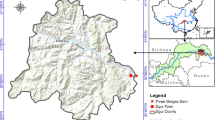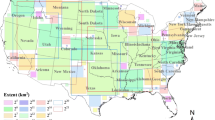Abstract
In this study, we investigated the sensitivity of landscape metrics to varying grain sizes in a rural, forested landscape in Japan, contributing to a broader understanding of landscape metric behavior across different scales. We analyzed six class-level and two landscape-level metrics on a land use map at grain sizes of 5, 10, 20, 30, 40, 50, 75, and 100 m. Our results indicate that the effect of increasing grain size on landscape metrics varies depending on the specific metric and land use type. Key metrics, such as the percentage of land use types in a landscape, and two landscape-level metrics showed minimal change across the range of grain sizes. Conversely, patch density and cohesion decreased, whereas Euclidean nearest neighbor distance increased. In addition, the patch area and radius of gyration showed variable responses across different land use types, influenced by their characteristic dimensions. This study highlights the limitations of using coarse-resolution data for detailed landscape analysis, as it may not fully capture landscape change or the relationship between landscape patterns and ecological processes. We propose an optimal grain size of 5–50 m for analyzing rural forested landscapes in Japan, which effectively captures fine-scale elements critical for biodiversity conservation. This range allows accurate comparisons between different regions and land use plans, especially in satoyama landscapes. This research highlights the importance of selecting appropriate grain size in landscape analysis and interpretation of landscape metrics as well as urges researchers and policymakers to ensure accurate ecological assessments and informed decision-making.









Similar content being viewed by others
References
Alhamad MN, Alrababah MA, Feagin RA, Gharaibeh A (2011) Mediterranean drylands: the effect of grain size and domain of scale on landscape metrics. Ecol Indic 11:611–621. https://doi.org/10.1016/j.ecolind.2010.08.007
Azareh A, Sardooi ER, Gholami H, Mosavi A, Shahdadi A, Barkhori S (2021) Detection and prediction of lake degradation using landscape metrics and remote sensing dataset. Environ Sci Pollut Res Int 28:27283–27298. https://doi.org/10.1007/s11356-021-12522-8
Betts MG, Diamond AW, Forbes GJ, Villard M-A, Gunn JS (2006) The importance of spatial autocorrelation, extent and resolution in predicting forest bird occurrence. Ecol Model 191:197–224. https://doi.org/10.1016/j.ecolmodel.2005.04.027
Bu H, Zhang Y, Meng W, Song X (2016) Effects of land-use patterns on in-stream nitrogen in a highly-polluted river basin in Northeast China. Sci Total Environ 553:232–242. https://doi.org/10.1016/j.scitotenv.2016.02.104
Chen J, Gupta AK (2012) Parametric statistical change point analysis, 2nd edn. Birkhäuser, Boston
Corry RC, Lafortezza R (2007) Sensitivity of landscape measurements to changing grain size for fine-scale design and management. Landsc Ecol Eng 3:47–53. https://doi.org/10.1007/s11355-006-0015-7
Corry RC, Nassauer JI (2005) Limitations of using landscape pattern indices to evaluate the ecological consequences of alternative plans and designs. Landsc Urban Plan 72:265–280. https://doi.org/10.1016/J.LANDURBPLAN.2004.04.003
Ene E, McGarigal K (2023) FragStats. https://fragstats.org/index.php/documentation. Accessed 31 Mar 2023
Esri (2021) ArcGIS desktop v. 10.8. Environmental Systems Research Institute, Redlands
Fahrig L (2003) Effects of habitat fragmentation on biodiversity. Annu Rev Ecol Evol Syst 34:487–515. https://doi.org/10.1146/annurev.ecolsys.34.011802.132419
Fan M, Shibata H (2015) Simulation of watershed hydrology and stream water quality under land use and climate change scenarios in Teshio river watershed, northern Japan. Ecol Indic 50:79–89. https://doi.org/10.1016/j.ecolind.2014.11.003
Forman RTT, Godron M (1986) Landscape ecology. John Wiley and Sons, New York
Fortin MJ, Boots B, Csillag F, Remmel TK (2003) On the role of spatial stochastic models in understanding landscape indices in ecology. Oikos 102:203–212. https://doi.org/10.1034/J.1600-0706.2003.12447.X
Fu G, Wang W, Li J, **ao N, Qi Y (2021) Prediction and selection of appropriate landscape metrics and optimal scale ranges based on multi-scale interaction analysis. Land. https://doi.org/10.3390/land10111192
Fukamachi K (2017) Sustainability of terraced paddy fields in traditional satoyama landscapes of Japan. J Environ Manag 202:543–549. https://doi.org/10.1016/j.jenvman.2016.11.061
Gardner RH, Milne BT, Turnei MG, O’Neill RV (1987) Neutral models for the analysis of broad-scale landscape pattern. Landsc Ecol 1:19–28. https://doi.org/10.1007/BF02275262
Havstad KM, Herrick JE (2003) Long-term ecological monitoring. Arid Land Res Manag 7:389–400. https://doi.org/10.1080/713936102
Huais PY (2018) multifit: an R function for multi-scale analysis in landscape ecology. Landsc Ecol 33:1023–1028. https://doi.org/10.1007/s10980-018-0657-5
Huang C, Geiger EL, Kupfer JA (2006) Sensitivity of landscape metrics to classification scheme. Int J Remote Sens 27:2927–2948. https://doi.org/10.1080/01431160600554330
Huang Z, Han L, Zeng L, **ao W, Tian Y (2016) Effects of land use patterns on stream water quality: a case study of a small-scale watershed in the three gorges reservoir area, China. Environ Sci Pollut Res 23:3943–3955. https://doi.org/10.1007/s11356-015-5874-8
Ichinose T, Takahashi T, Katoh K, Osawa S, Sugimura S (2008) A biotope type map** procedure suitable for habitat evaluation in Japanese rural areas. J Rural Plan Assoc 27:7–13. https://doi.org/10.2750/arp.27.7
Kadoya T, Washitani I (2011) The satoyama index: a biodiversity indicator for agricultural landscapes. Agric Ecosyst Environ 140:20–26. https://doi.org/10.1016/J.AGEE.2010.11.007
Kato S, Ahern J (2011) The concept of threshold and its potential application to landscape planning. Landsc Ecol Eng 7:275–282
Kato S, Huang W (2021) Land use management recommendations for reducing the risk of downstream flooding based on a land use change analysis and the concept of ecosystem-based disaster risk reduction. J Environ Manag 287:112341. https://doi.org/10.1016/J.JENVMAN.2021.112341
Katoh K, Sakai S, Takahashi T (2009) Factors maintaining species diversity in satoyama, a traditional agricultural landscape of Japan. Biol Conserv 142:1930–1936. https://doi.org/10.1016/j.biocon.2009.02.030
Kumar M, Denis DM, Singh SK, Szabó S, Suryavanshi S (2018) Landscape metrics for assessment of land cover change and fragmentation of a heterogeneous watershed. Remote Sens Appl 10:224–233. https://doi.org/10.1016/j.rsase.2018.04.002
Leitão AB, Miller J, Ahern J, McGarigal K (2006) Measuring landscapes: a planner’s handbook. Island Press, Washington, D.C.
Li H, Wu J (2004) Use and misuse of landscape indices. Landsc Ecol 19:389–399. https://doi.org/10.1023/B:LAND.0000030441.15628.d6
Li X, He HS, Bu R, Wen Q, Chang Y, Hu Y, Li Y (2005) The adequacy of different landscape metrics for various landscape patterns. Pattern Recognit 38:2626–2638. https://doi.org/10.1016/j.patcog.2005.05.009
McGarigal K, Marks BJ (1995) FRAGSTATS: spatial pattern analysis program for quantifying landscape structure. US Department of Agriculture Forest Service, Pacific Northwest Research Station, Portland
McGarigal K, Cushman SA, Ene E (2023) FRAGSTATS: spatial pattern analysis program for categorical maps. Computer software program produced by the authors at the University of Massachusetts, Amherst. www.umass.edu/landeco/research/fragstats/fragstats.html. Accessed 10 Dec 2023
MLIT (2021) Land use categories. https://nlftp.mlit.go.jp/ksj/gml/codelist/LandUseCd-09.html. Accessed 2 Apr 2023
Morimoto Y (2011) What is satoyama? points for discussion on its future direction. Landsc Ecol Eng 7:163–171. https://doi.org/10.1007/s11355-010-0120-5
Muggeo VMR (2003) Estimating regression models with unknown break-points. Stat Med 22:3055–3071. https://doi.org/10.1002/sim.1545
Parent JR, Volin JC (2016) Validating Landsat-based landscape metrics with fine-grained land cover data. Ecol Indic 60:668–677. https://doi.org/10.1016/j.ecolind.2015.08.009
R Core Team (2022) R: a language and environment for statistical computing. R Foundation for Statistical Computing, Vienna. https://www.R-project.org/. Accessed 4 Apr 2023
Sadeghi SH, Moradi Dashtpagerdi M, Moradi Rekabdarkoolai H, Schoorl JM (2021) Sensitivity analysis of relationships between hydrograph components and landscapes metrics extracted from digital elevation models with different spatial resolutions. Ecol Indic 121:107025. https://doi.org/10.1016/j.ecolind.2020.107025
Saura S (2004) Effects of remote sensor spatial resolution and data aggregation on selected fragmentation indices. Landsc Ecol 19:197–209. https://doi.org/10.1023/B:LAND.0000021724.60785.65/METRICS
Schumaker NH (1996) Using landscape indices to predict habitat connectivity. Ecology 77:1210–1225. https://doi.org/10.2307/2265590
Takeuchi K, Ichikawa K, Elmqvist T (2016) Satoyama landscape as social-ecological system: historical changes and future perspective. Curr Opin Environ Sustain 19:30–39
Tottori Prefecture (2020) Number of farmers and arable land area in Tottori Prefecture. https://www.pref.tottori.lg.jp/202656.htm. Accessed 28 Jun 2023
Turner MG, O’Neill RV, Gardner RH, Milne BT (1989) Effects of changing spatial scale on the analysis of landscape pattern. Landsc Ecol 3:153–162. https://doi.org/10.1007/BF00131534
Wakasa Town (2021) Town overview census 2021. https://www.town.wakasa.tottori.jp/gyoseijoho/wakasachonogaiyo/633.html. Accessed 22 Mar 2023
Wickham JD, Riitters KH (1995) Sensitivity of landscape metrics to pixel size. Int J Remote Sens 16:3585–3594. https://doi.org/10.1080/01431169508954647
Wu J, Hobbs R (2002) Key issues and research priorities in landscape ecology: an idiosyncratic synthesis. Landsc Ecol 17:355–365. https://doi.org/10.1023/A:1020561630963
Wu J, Lu J (2021) Spatial scale effects of landscape metrics on stream water quality and their seasonal changes. Water Res 191:116811. https://doi.org/10.1016/j.watres.2021.116811
Wu J, Shen W, Sun W, Tueller PT (2002) Empirical patterns of the effects of changing scale on landscape metrics. Landsc Ecol 17:761–782. https://doi.org/10.1023/A:1022995922992/METRICS
Yazu Town (2022) Town overview census 2021. https://www.town.yazu.tottori.jp/soshiki/1/1025.html#youran. Accessed 22 Mar 2023
Yazu Town (2023) Town overview. http://www.town.yazu.tottori.jp/1002.htm. Accessed 22 Mar 2023
Zhang S, Fan W, Li Y, Yi Y (2017) The influence of changes in land use and landscape patterns on soil erosion in a watershed. Sci Total Environ 574:34–45. https://doi.org/10.1016/j.scitotenv.2016.09.024
Zhang Q, Chen C, Wang J, Yang D, Zhang Y, Wang Z, Gao M (2020) The spatial granularity effect, changing landscape patterns, and suitable landscape metrics in the three gorges reservoir area, 1995–2015. Ecol Indic 114:106259. https://doi.org/10.1016/J.ECOLIND.2020.106259
Zhao Y, Tomita M, Harada I, Hara K (2011) Multi-scale effect on landscape pattern analysis using satellite data with a range of spatial resolutions. J Landsc Ecol 4:62–72. https://doi.org/10.2478/v10285-012-0039-7
Acknowledgements
This work was supported by Tottori University of Environmental Studies Grant-in-Aid for Special Research. We thank the reviewers of earlier versions of the manuscript for their valuable comments and suggestions.
Author information
Authors and Affiliations
Corresponding author
Ethics declarations
Conflict of interest
The authors declare that they have no known competing financial interests or personal relationships that could have appeared to influence the work reported in this paper.
Ethical approval
The experiments comply with the current laws of the country in which they were performed.
Rights and permissions
Springer Nature or its licensor (e.g. a society or other partner) holds exclusive rights to this article under a publishing agreement with the author(s) or other rightsholder(s); author self-archiving of the accepted manuscript version of this article is solely governed by the terms of such publishing agreement and applicable law.
About this article
Cite this article
Kato, S., Motobe, A. Landscape metric sensitivity to grain size in rural Japan. Landscape Ecol Eng (2024). https://doi.org/10.1007/s11355-024-00611-y
Received:
Revised:
Accepted:
Published:
DOI: https://doi.org/10.1007/s11355-024-00611-y




